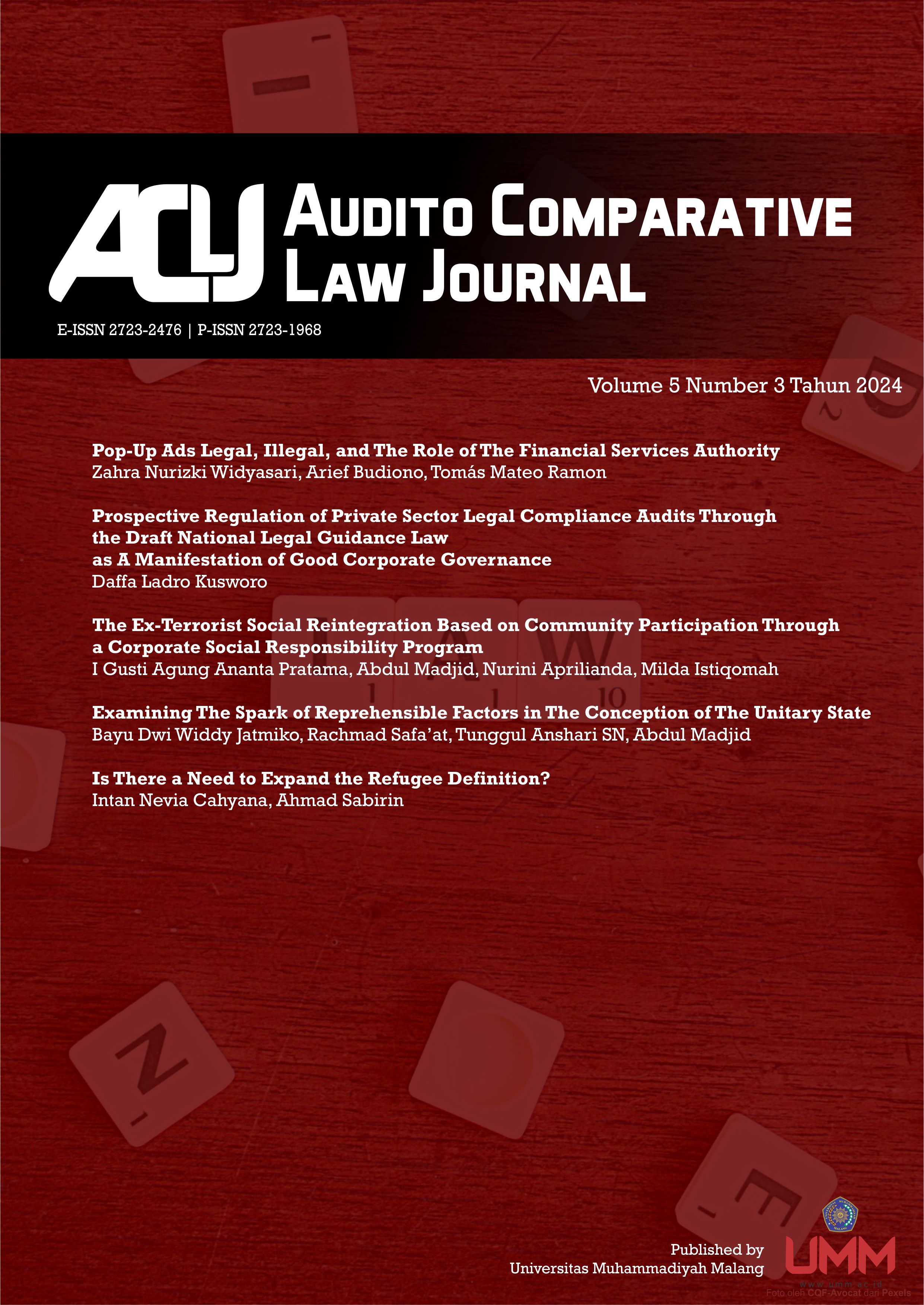Is There a Need to Expand the Refugee Definition?
DOI:
https://doi.org/10.22219/aclj.v5i3.34057Keywords:
Rohingya; Refugees; Climate Refugees; International LawAbstract
This article examines the urgency of protecting against displacement caused by climate change under international law and questions why Rohingya displacement has not been resolved even though it has been protected by international law, whether the harmonization of human rights approaches, national law, and international law towards refugees and climate refugees. This paper uses a literature review method and a normative legal approach by reviewing national and international human rights law. The findings of this paper suggest that many Rohingya continue to flee to safer countries, often taking enormous risks, including dangerous ocean crossings. The impacts of climate change can be categorized as persecution; the Refugee Convention requires that such persecution be due to race, religion, nationality, political opinion, or membership of a particular social group. Persecution alone is not enough. The difficulty is that the impacts of climate change are largely indiscriminate and not related to specific characteristics such as a person's background or beliefs. The Rohingya people have experienced violence, discrimination, and persecution for decades, and the international community has failed to protect them effectively. The international community has allowed Myanmar to carry out genocide against the Rohingya without taking any action, even though United Nations member states are obliged to protect their population from genocide, war crimes, ethnic cleansing, and crimes against humanity. National, international, and human rights laws play an important role in determining the legal status and rights of refugees in a country. All three must be embedded and integrated, starting from international law and its derivatives to national law, which contains humanitarian rights.
Downloads
References
Atapattu, Sumudu. 2015. Human Rights Approaches to Climate Change: Challenges and Opportunities. Routledge.
Bacaian, Livia Elena. 2011. The Protection of Refugees and Their Right to Seek Asylum in the European Union. Institut européen de l’Université de Genève.
Baumgärtel, Moritz, and Sara Miellet. 2022. Theorizing Local Migration Law and Governance. Cambridge University Press.
Cantor, David James. 2023. “Conceptualising ‘Relocation’ Across Displacement Contexts.” Journal of International Humanitarian Legal Studies, October, 1–29. https://doi.org/10.1163/18781527-bja10083.
Chaturvedi, Sanjay, and Timothy Doyle. 2010. “Geopolitics of Fear and the Emergence of ‘Climate Refugees’: Imaginative Geographies of Climate Change and Displacements in Bangladesh.” Journal of the Indian Ocean Region 6 (2): 206–22. https://doi.org/10.1080/19480881.2010.536665.
Cooper, Jessica B. 1997. “Environmental Refugees: Meeting the Requirements of the Refugee Definition.” NYU Envtl. LJ 6:480.
d’Amato, Anthony. 2017. “The Concept of Human Rights in International Law.” In International Law of Human Rights, 21–70. Routledge.
Dussich, John P. J. 2018. “The Ongoing Genocidal Crisis of the Rohingya Minority in Myanmar.” Journal of Victimology and Victim Justice 1 (1): 4–24. https://doi.org/10.1177/2516606918764998.
Faruque, Taufiq -E-. 2020. “Rohingya Refugee Crisis in Bangladesh: The Case of UNHCR’s Response.” Jurnal Hubungan Internasional 9 (1). https://doi.org/10.18196/hi.91160.
Gibb, Christine, and James Ford. 2012. “Should the United Nations Framework Convention on Climate Change Recognize Climate Migrants?” Environmental Research Letters 7 (4): 045601. https://doi.org/10.1088/1748-9326/7/4/045601.
Goodwin-Gill, Guy S. 2019. “The Global Compacts and the Future of Refugee and Migrant Protection in the Asia Pacific Region.” International Journal of Refugee Law 30 (4): 674–83. https://doi.org/10.1093/ijrl/eey064.
Goodwin-Gill, Guy S, Jane McAdam, and Emma Dunlop. 2021. The Refugee in International Law. Oxford University Press.
Haryadi, Y. F. R. 20224. “In Perspective of International Legal Protection Law, the Rohingya Refugee Crisis.” Journal of ASEAN Dynamics and Beyond, no. 1, 24–31. https://doi.org/https://doi.org/10.20961/aseandynamics.v4i1.69508.
Himel Rahman. 2023. “SAV Explainer: International Law Has Failed to Protect the Rohingya Refugees.” South Asian Voice, October 10, 2023. https://southasianvoices.org/rohingya-refugees/.
Hiraide, Lydia Ayame. 2023. “Climate Refugees: A Useful Concept? Towards an Alternative Vocabulary of Ecological Displacement.” Politics 43 (2): 267–82. https://doi.org/10.1177/02633957221077257.
Hossain, A N M Zakir. 2022. “Geopolitics of Rohingya Refugee Crisis and Regional Security.” International Journal of Safety and Security Engineering 12 (2): 167–77. https://doi.org/10.18280/ijsse.120204.
Imran, Hassan Faruk Al, and Nannu Mian. 2014. “The Rohingya Refugees in Bangladesh: A Vulnerable Group in Law and Policy.” Journal of Studies in Social Sciences 8 (2).
Ishaq, Ishaq. 2017. “Metode Penelitian Hukum Dan Penulisan Skripsi, Tesis, Serta Disertasi.” Alfabeta.
Janmyr, Maja. 2018. “UNHCR and the Syrian Refugee Response: Negotiating Status and Registration in Lebanon.” The International Journal of Human Rights 22 (3): 393–419. https://doi.org/10.1080/13642987.2017.1371140.
Jolly, Stellina, and Nafees Ahmad. 2019. “Climate Refugees: The Role of South Asian Judiciaries in Protecting the Climate Refugees.” In , 203–54. https://doi.org/10.1007/978-981-13-3137-4_6.
Kartiwa, Rahmat, and Zakiah Jalianty. 2023. “Analysis of the Role of Indonesia’s Active Free Diplomacy in Resolving the Rohingya Conflict.” Social Impact Journal 2 (2): 62–68.
Kingston, Lindsey N. 2018. “Protecting the World’s Most Persecuted: The Responsibility to Protect and Burma’s Rohingya Minority.” In The Responsibility to Protect, 179–91. Routledge.
Kipgen, Nehginpao. 2013. “Conflict in Rakhine State in Myanmar: Rohingya Muslims’ Conundrum.” Journal of Muslim Minority Affairs 33 (2): 298–310. https://doi.org/10.1080/13602004.2013.810117.
László, Emese Laura, and Johannes Dragsbæk Schmidt. 2018. “The Impact of Refugees on Host Countries: A Case Study of Bangladesh under the Rohingya Influx.” Aalborg University Aalborg, Denmark.
María José Fernández. 2015. “Disasters and Displacement in a Changing Climate: Refugees, Climate Change and International Law.” Fmreview, May 2015. https://www.fmreview.org/sites/fmr/files/FMRdownloads/en/climatechange-disasters/fernandez.pdf.
McAdam, Jane. 2016. “From the Nansen Initiative to the Platform on Disaster Displacement: Shaping International Approaches to Climate Change, Disasters and Displacement.” UNSWLJ 39:1518.
McMichael, Celia. 2023. “Climatic and Environmental Change, Migration, and Health.” Annual Review of Public Health 44 (1): 171–91. https://doi.org/10.1146/annurev-publhealth-071421-045148.
Moretti, Sébastien. 2021. “Southeast Asia and the 1951 Convention Relating to the Status of Refugees: Substance without Form?” International Journal of Refugee Law 33 (2): 214–37. https://doi.org/10.1093/ijrl/eeab035.
Mutaqin, Zezen Zaenal. 2018. “The Rohingya Refugee Crisis and Human Rights: What Should ASEAN Do?” Asia-Pacific Journal on Human Rights and the Law 19 (1): 1–26.
Nasution, Bahder Johan. 2016. Metode Penelitian Ilmu Hukum. 1st ed. Bandung: Mandar Maju.
Neef, Katja, Evan Jones, and Jay Marlowe. 2023. “The Conflict, Climate Change, and Displacement Nexus Revisited: The Protracted Rohingya Refugee Crisis in Bangladesh.” Journal of Peacebuilding & Development 18 (3): 231–47. https://doi.org/10.1177/15423166231190040.
Neves, Diana, Patrícia Baptista, and João M. Pires. 2021. “Sustainable and Inclusive Energy Solutions in Refugee Camps: Developing a Modelling Approach for Energy Demand and Alternative Renewable Power Supply.” Journal of Cleaner Production 298 (May):126745. https://doi.org/10.1016/j.jclepro.2021.126745.
Nirmal, B C, and Prakash Sharma. 2020. “Responsibility Sharing under International Refugee Law with Special Reference to Global Compact on Refugees.” -21 ISIL YB Int’l Human. & Refugee L. 20:213.
Nowak, M. 2007. “The Need for a World Court of Human Rights.” Human Rights Law Review 7 (1): 251–59. https://doi.org/10.1093/hrlr/ngl026.
Parashar, Archana, and Jobair Alam. 2019. “The National Laws of Myanmar: Making of Statelessness for the Rohingya.” International Migration 57 (1): 94–108. https://doi.org/10.1111/imig.12532.
Pécoud, Antoine. 2021. “Narrating an Ideal Migration World? An Analysis of the Global Compact for Safe, Orderly and Regular Migration.” Third World Quarterly 42 (1): 16–33. https://doi.org/10.1080/01436597.2020.1768065.
Sinari, Yuthi, Suhaidi Suhaidi, and Jelly Leviza. 2013. “Status Hukum Dan Perlindungan Environmentally Displaced Persons Ditinjau Dari Konvensi 1951 Tentang Status Pengungsi.” Sumatra Journal of International Law 1 (2).
Sritharan, Elijah S. 2023. “Climate Change-Related Displacement and the Determination of Refugee Status under the 1951 Refugee Convention.” LeXonomica 15 (1). https://doi.org/10.18690/lexonomica.15.1.1-32.2023.
STRAIF, JANINA. 2019. “The Transnational Rohingyas In Southeast Asia And Beyond: Stateless Identity And Migration Experience.”
Sudheer, Nivedita, and Debanjan Banerjee. 2021. “The Rohingya Refugees: A Conceptual Framework of Their Psychosocial Adversities, Cultural Idioms of Distress and Social Suffering.” Global Mental Health 8 (December):e46. https://doi.org/10.1017/gmh.2021.43.
Syahrin, M. Alvi. 2018. “The Rohingya Refugee Crisis: Legal Protection on International Law and Islamic Law.” In Proceedings of the 1st International Conference on Indonesian Legal Studies (ICILS 2018). Paris, France: Atlantis Press. https://doi.org/10.2991/icils-18.2018.18.
Tyler Bergeron. 2023. “Environmental, Natural Resources, & Energy Law Blog "No Refuge for ‘Climate Refugees’ in International Law.” Lclark.Ed, January 20, 2023. https://www.lclark.edu/live/blogs/200-no-refuge-for-climate-refugees-in-international.
Warner, Koko. 2018. “Coordinated Approaches to Large-Scale Movements of People: Contributions of the Paris Agreement and the Global Compacts for Migration and on Refugees.” Population and Environment 39 (4): 384–401. https://doi.org/10.1007/s11111-018-0299-1.
WILLIAMS, ANGELA. 2008. “Turning the Tide: Recognizing Climate Change Refugees in International Law.” Law & Policy 30 (4): 502–29. https://doi.org/10.1111/j.1467-9930.2008.00290.x.
Yazdanie, M., P.B. Frimpong, J.B. Dramani, and K. Orehounig. 2024. “The Impacts of the Informal Economy, Climate Migration, and Rising Temperatures on Energy System Planning.” Energy Reports 11 (June):165–78. https://doi.org/10.1016/j.egyr.2023.11.041.
Zahed, Iqthyer Uddin Md. 2021. “The State against the Rohingya: Root Causes of the Expulsion of Rohingya from Myanmar.” Politics, Religion & Ideology 22 (3–4): 436–60. https://doi.org/10.1080/21567689.2021.1995716.
Downloads
Published
How to Cite
Issue
Section
License
Copyright (c) 2024 Intan Nevia Cahyana, Ahmad Sabirin

This work is licensed under a Creative Commons Attribution-ShareAlike 4.0 International License.








